The Ford, Past and Future
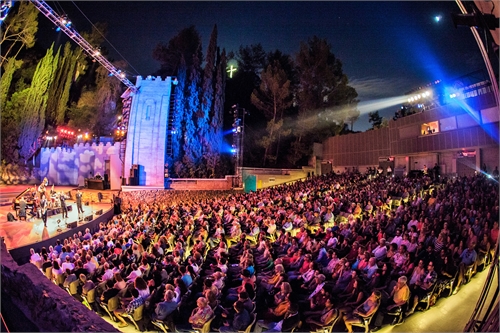
Preservation Hall Jazz Band on the Ford Amphitheatre stage. Photo: Gennia Cui
The John Anson Ford Amphitheatre is one of the oldest performing arts venues still active in Los Angeles today. For nearly 100 years, audiences have gathered at this memorable venue to share in magical and intimate moments with artists of all kinds. With ambitious artistic beginnings, this 32-acre County regional park located across from the Hollywood Bowl in the Cahuenga Pass continues to dedicate its 1,200 seat outdoor theatre space to a diverse roster of local musical and performance events in Los Angeles County. In addition to its renowned summer season, the Ford presents interactive art events at the amphitheater and throughout Los Angeles making it a constant hub for local residents to have an authentic LA experience. However, years aged the Ford Theatres beautiful historic site making extensive renovations and updating necessary. Now, after three years and $65.8 million, the refurbished John Anson Ford Amphitheatre reopens its doors as one of the premiere outdoor venues for live entertainment in Los Angeles.
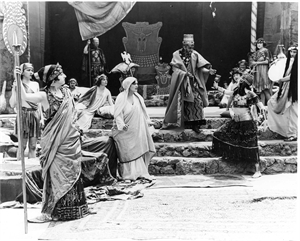 Left: The Pilgrimage Play-–the original purpose for building the theatre-–ran from 1920 through 1964 with interruptions from a destructive fire and World War II. Photo: LA Public Library
Left: The Pilgrimage Play-–the original purpose for building the theatre-–ran from 1920 through 1964 with interruptions from a destructive fire and World War II. Photo: LA Public Library
The Ford Theatres began in 1920, when Christine Wetherill Stevenson, heiress to the Pittsburgh Paint Company fortune, left the summer amphitheater project that was to become the Hollywood Bowl due to creative differences. Mrs. Stevenson had written a Pilgrimage Play, an interpretation of the first four gospels according to the Kings James Version of the Bible, and wanted a dedicated space for its performance. Believing the dramatic outdoor scenery of the area would be the perfect setting for her play, she purchased 28 acres in the Cahuenga Pass Canyon and commissioned Ellis Reed to build the first rudimentary structure, which was eventually developed into the beautiful Pilgrimage Play Theatre. The first performance of the Pilgrimage Play was held on June 27, 1920, and the tradition that Mrs. Stevenson wished to begin continued long after her premature death in 1922. Each summer, the Pilgrimage Play was performed with notable actors until 1929 when the original wooden structure was destroyed by a brush fire.
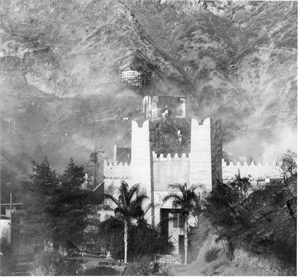
Right:The 1929 fire destroyed the wooden structures, and was rebuilt in concrete in 1931. Photo: Herald Examiner Collection
In 1931, a new theater was constructed of concrete and designed in the style of ancient Judaic architecture meant to resemble the gates of Jerusalem and the summer tradition continued. The performance was met with another brief interruption in 1940 during World War II when the dressing rooms were converted into sleeping quarters for servicemen as they passed through Hollywood.
In 1941, the Pilgrimage Play Association deeded the property to the County of Los Angeles and in 1964, the Pilgrimage Play made its final curtain call when church and state politics brought a lawsuit against the County for using a County facility exclusively for a religious performance. Today, the only reminder is the symbolic cross above.
In 1976, to honor the late LA County Supervisor’s support of the arts, the theatre was renamed the John Anson Ford Amphitheatre. John Anson Ford helped create the Los Angeles County Arts Commission, encouraged the building of The Music Center and worked to acquire the Descanso Gardens among many other achievements. The Amphitheatre continued to serve as the summer home for Shakespearean theater, long-running free Jazz concerts, and dance performances but the audience dwindled and the facilities slowly deteriorated. In the late 80’s, the Ford Amphitheatre served as one of LA’s biggest punk music venues with legendary performances by bands such as Janes Addiction, Red Hot Chili Peppers, and the Ramones.
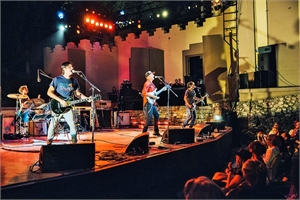 Left:Tom Morello and Jail Guitar Doors. Photo: Gennia Cui
Left:Tom Morello and Jail Guitar Doors. Photo: Gennia Cui
In the 90s, former County Supervisor Ed Edelman obtained funding for capital improvements and began to revamp the theatre creating Summer Nights at the Ford, the Fords now famous summer season. As a program of the Los Angeles County Arts Commission, the Ford summer season was designed to allow music, dance and theatre groups in LA County a major venue for performances. Each group was selected through a competitive application process, receiving front of the house, production, and marketing support as well as the majority of the box office proceeds. This promising program, whose inaugural season began in the summer of 1993 with only 12 performances, blossomed into an annual summer season with over 70 events supporting hundreds of local arts organizations. In 2008, the Arts Commission, Department of Parks and Recreation and Ford Theatre Foundation worked with the architectural firm Levin & Associates to create the Ford Theatres Project, a comprehensive rehabilitation plan for the historic facility that addressed needed improvements in a multi-phased plan to expand the experiences of artists and audiences alike. Former County Supervisor Zev Yaroslavsky was a major motivator behind the project, which began in 2013 with the installation of new seats and restoration of the iconic Judaic architecture to its former unpainted concrete.
The most recent phase of the plan began in September 2014, preempting the summer 2015 season and will be finished just in time for the summer 2016 season opening this July. Some of the improvements have been invisible to the eye but restorative to the land such as hillside stabilization and drainage improvements. One of the most notable changes is a new sound barrier that will muffle the noise from the 101 Freeway. Artists and audiences will appreciate the newly reconstructed stage with new lighting and infrastructure improvements. The 87-seat indoor theater, called Inside the Ford, is being repurposed as an indoor self-serve food market. This was a necessary decision as the indoor theatre could not be used simultaneously with the outdoor theatre due to noise and it will offer visitors a cozy new indoor market. A new picnic terrace and raised deck above a loading dock and vehicle turnaround will accommodate around 125 people who can order from the theatres new concession services and enjoy an outdoor eating experience. The plan for the concession services is to include a full kitchen and Crumble Catering will develop a menu that will include full dinners. An upper-level office space will complete the acoustical envelope for the theatre. The picnic terrace and concession stands are expected to be completed by August when the County and Ford Theatre Foundation will hold a dedication ceremony.
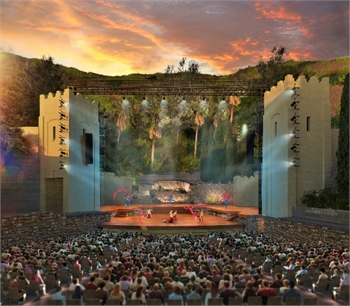
Right: Rendering of the new stage courtesy of Levin & Associates
Funding for the nearly $66 million in renovations came from L.A. County capital project funds with additional support from private donors. The current phase of the project came in around 17 percent over the original estimate due to unforeseen events but it is residents’ tax dollars at work to continue to bring local culture to the venue. Future plans awaiting funding include The Ford Plaza with a restaurant, 299-seat theatre, box office, conference rooms, and visitor amenities. The existing box office would be converted into a museum and gallery. There are plans to create a transit center for bus/van loading and unloading, a three-level parking structure and a rehearsal and event space. Finally, an approximate 0.75-mile formal ridgeline-hiking trail would be created to allow visitors access to scenic views of the Hollywood Reservoir, Hollywood Sign, and Griffith Observatory. From the early days of The Pilgrimage Play to performances from some of LA’s most beloved artists, the Ford has become a treasured landmark in Los Angeles’ history and will continue to pave the way for an incredible future for Los Angeles performing arts.